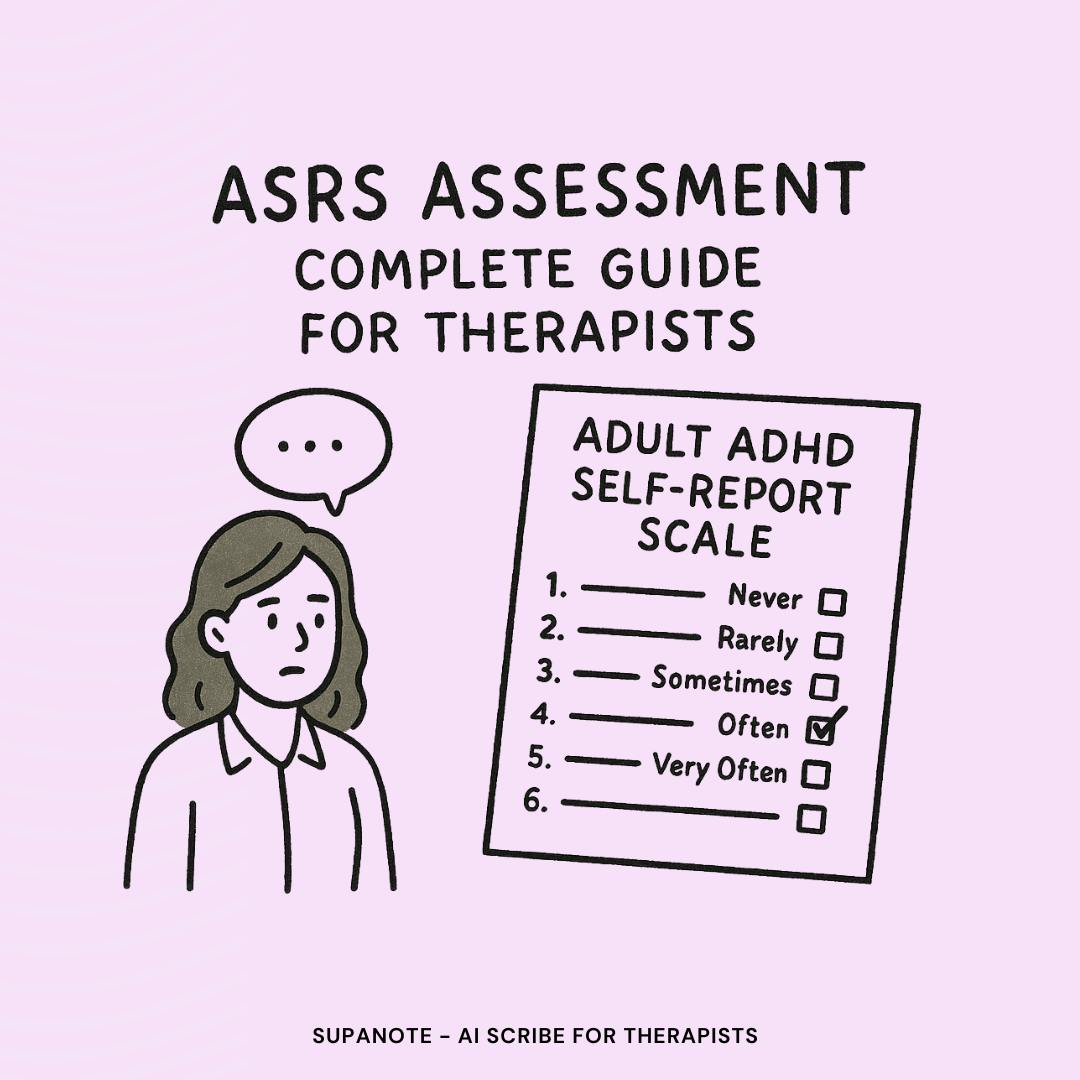You know that client....
The one who seems anxious but describes problems remembering appointments and struggles with boring or difficult projects. They start strong but can't finish especially wrapping up the final details of a project once the challenging parts are done.
That’s not just anxiety - it could be ADHD hiding in plain sight.
The Adult ADHD Self-Report Scale (ASRS) helps in cutting through that confusion. It's the difference between another "anxious" client and actually catching ADHD before it derails their life.

What is the ASRS Assessment?
The ASRS v1.1 is an 18-item self-report screening tool developed collaboratively by the World Health Organization and Harvard Medical School researchers.
It's based on DSM-IV criteria but still works for today's diagnostic standards. The core symptoms of attention deficit hyperactivity disorder haven't changed according to the American Psychiatric Association's Diagnostic and Statistical Manual.
How it's structured?
The ASRS has two main parts that work together to give you a complete picture:
- Part A (6 questions): The most important section - these questions are best at spotting ADHD
- Part B (12 questions): Gives you extra details about symptoms and severity
Why it works in your practice ?
- Quick to use: Takes just 5-15 minutes
- Reliable results: Backed by solid research
- Widely accessible: Available in 20+ languages
- Easy to score: Clear guidelines for interpretation
You can also download the official ASRS v1.1 PDF which includes all 18 questions (Parts A & B), a 0–4 Likert scale, and scoring guidance.
You can use it to:
- Send it to clients ahead of the session
- Fill it out during intake
- Use it to guide ADHD evaluation or referral
It takes just 5–10 minutes but can change how you understand a client’s symptoms.
Understanding the Two-Part Structure and Two Subscales
Part A: Your Diagnostic Powerhouse
Part A contains 6 questions that are most predictive of ADHD diagnoses.
Scoring : 4 or more positive responses indicates ADHD symptoms consistent with adult ADHD diagnosis.
What Part A captures:
- Difficulty concentrating on tasks that requires organization
- Trouble organizing work and handling boring or repetitive work
- Problems with follow-through on a task once motivation wanes
- Avoiding tasks requiring sustained mental effort
- Trouble remaining seated in meetings or other situations
- Feeling restless or feel overly active
Part B: The Deeper Dive
Part B has 12 questions about the two subscales: inattention and hyperactivity-impulsivity. It shows how severe symptoms are and helps plan treatment.
While less predictive than Part A, it offers valuable clinical information for treatment planning and understanding ADHD traits.
Scoring: 27+ means your client needs more evaluation.
The Updated Scoring System: What Changed?
Harvard Medical School updated the scoring in 2024, moving from a dichotomous scoring system to a more nuanced Likert-based approach.
Quick Visual: The Likert Scale at a Glance
The ASRS now uses a 5-point scale for each item to reflect how frequently symptoms occur:
Frequency | Score |
|---|---|
Never | 0 |
Rarely | 1 |
Sometimes | 2 |
Often | 3 |
Very Often | 4 |
This update adds nuance. A client scoring “Sometimes” across most items paints a very different clinical picture than someone scoring “Very Often” across the board.
Use this scale to:
- Spot symptom severity
- Track consistency across subscales
- Differentiate between occasional distraction vs. likely ADHD
ADHD Subtypes: What the Two Subscales Reveal
The Adult ADHD Self-Report Scale (ASRS) has two subscales that can be used to identify specific ADHD presentations:
Inattention subscale (Questions 1-4, 7-11):
- Poor attention to details and careless mistakes
- Difficulty concentrating and sustaining attention
- Not listening when spoken to directly
- Trouble with tasks that requires organization
- Difficulty finding things and losing important items
- Problems remembering appointments or obligations
Hyperactivity-Impulsivity subscale (Questions 5-6, 12-18):
- Difficulty remaining seated and trouble sitting still
- Feeling restless and difficulty unwinding
- Difficulty waiting and problems with turn taking in social situations
- Feel overly active like driven by a motor
- Interrupting others and talking excessively
Interpreting Results: Beyond the Numbers
Part A Interpretation
- 14+ total score: Symptom profile consistent with DSM-IV criteria and current diagnostic standards
- High/Very High range: Clinically significant symptoms requiring further evaluation
Part B Context
- 27+ score: Clinically significant additional symptom burden
- Percentile rankings: Compare client responses to normative adult data
Total Score Percentile
Most adults with ADHD score above the 79th percentile (raw score of 40).
This gives you context for how your client's symptoms compare to the general population and helps inform next steps in the diagnostic process.
Clinical Applications: When and How to Use the ASRS
Prime Candidates for ASRS Screening
Present with these patterns:
- Chronic disorganization despite intelligence
- Starting projects but difficulty wrapping up the final details
- Relationship issues related to forgetfulness or impulsivity
- Work performance inconsistent with ability, especially with boring or repetitive work
- Comorbid anxiety or depression that's treatment-resistant
- Problems remembering appointments despite using reminder systems
Red flags during intake:
- "I've always been this way"
- History of academic underachievement
- Multiple job changes or relationship patterns
- Substance use for self-medication
- Difficulty with any task that requires organization
Integration with Your Assessment Process
Step 1: Pre-session preparation
Send the ASRS electronically before the appointment.
This saves session time and gives patients space to reflect thoughtfully on their symptoms.
Step 2: Review and explore
Don't just score it, use it as a conversation starter.
Ask about specific examples behind high-scoring items, particularly around difficulty keeping focus during boring or difficult projects.
Step 3: Combine with clinical interview
The Adult ADHD Self-Report Scale (ASRS v1.1) should complement, not replace, thorough clinical assessment. Consider adding the WURS-25 to evaluate childhood ADHD symptoms retrospectively for comprehensive evaluation.
Common Clinical Scenarios
Scenario 1: The High-Achieving Professional
Sarah, 29, MBA, reports chronic procrastination and feeling "scattered" despite career success. She mentions difficulty with boring or repetitive work and trouble wrapping up projects.
ASRS results: Part A score of 15, Part B score of 28
Clinical insight: High scores might suggest ADHD despite compensatory success strategies.
Explore how much energy she expends managing symptoms and difficulty concentrating.
Scenario 2: The Anxious Client
Mark, 35, presents with anxiety but mentions lifelong attention difficulties and problems remembering appointments.
ASRS results: Part A score of 12, Part B score of 22
Clinical consideration: Below diagnostic threshold but worth monitoring.
ADHD and anxiety often co-occur untreated attention deficit hyperactivity disorder can manifest as anxiety symptoms.
Scenario 3: The Resistant Teenager (Young Adult)
Alex, 19, college student struggling academically, parents suggest ADHD evaluation. Reports difficulty with any task that requires organization.
ASRS results: Part A score of 18, Part B score of 35
Treatment implication: Clear indication for comprehensive ADHD evaluation.
High scores across both subscales suggest significant functional impairment requiring formal diagnosis consideration.
Documenting Results
Progress Note Example
"Client completed Adult ADHD Self-Report Scale (ASRS v1.1) with Part A score of 16 (threshold: 14+) and Part B score of 29 (significant: 27+), indicating symptom profile consistent with adult ADHD diagnosis per DSM-IV criteria. Self-reported difficulty concentrating, problems remembering appointments, and trouble with boring or difficult projects. Recommend comprehensive ADHD evaluation."
Next Steps
- Score 14+ on Part A: Send for full ADHD evaluation
- Scores 10-13: Monitor symptoms, maybe retest after treating other mental disorders
- Score <10: ADHD unlikely main problem
Skip the Documentation Headache
We all know the drill - great session with a client, then an hour writing notes about it.
Modern AI tools like Supanote can automatically pull ASRS test results into your documentation. We're talking about cutting your note-writing time from 45 minutes down to about 5.
Here's how Supanote handles your ASRS workflow:
- Listens to your session and catches the assessment details
- Pulls in ASRS scores automatically
- Writes notes that actually sound like you wrote them
- Everything stays HIPAA-compliant without you thinking about it
The result? Notes that include your ASRS findings, client responses, and next steps - all ready for insurance review. You spend less time typing and more time doing what you actually trained for.
Ready to Try? 10 notes on us!
Login to your Supanote account and instantly access 10 free notes
Get it Now!
What the ASRS Can't Do
Limitations
- Can't rule out other mental disorders: Depression, anxiety, trauma can look like ADHD symptoms
- No formal diagnosis: Always needs full interview with qualified medical professional
- Doesn't catch masking: High-functioning people might underreport hyperactivity symptoms
Cultural Factors
Think about how culture affects reporting. Women especially might have learned to hide hyperactivity and may not feel overly active compared to men.
Making ADHD Assessment Accessible
ADHD assessment isn't about finding problems - it's about understanding how clients' brains work and building on strengths while managing challenges.
Many adults seeking ADHD evaluation have felt "broken" for years, especially when struggling with tasks that requires organization or feeling restless in other situations.
The Adult ADHD Self-Report Scale (ASRS) can start their journey toward understanding and effective treatment.
The self-report scale ASRS v1.1 helps because it normalizes common experiences. Many clients feel relieved learning that difficulty unwinding, problems with turn taking, or trouble with boring or difficult projects are recognized symptoms, not personal failures.
Resources for Learning More
Professional Groups:
- CHADD (Attention Deficit Hyperactivity Disorder support)
- AACAP (Child & Adolescent Psychiatry)
- American Psychiatric Association ADHD resources
Assessment Tools:
- Harvard Medical School ASRS materials
- ASRS v1.1 in multiple languages
- World Health Organization ADHD screening resources
Frequently Asked Questions
Q: How often should I re-administer the ASRS?
A: Only when there are significant life changes, medication adjustments, or if initial scores were borderline. It's a screening tool, not a progress measure.
Q: Can I use the ASRS with patients under 18?
A: No, it's developed for adults 18+. Use Conners-3 or ADHD Rating Scale-IV for teens.
Q: What if Part A is high but Part B is low?
A: Still significant. Part A is most predictive—proceed with comprehensive evaluation.
Q: How do I handle potential over-reporting?
A: Use other information, ask for specific examples, and consider objective testing during full evaluation.
Q: Should I adjust scores for anxiety/depression?
A: No. Don't adjust scores, but note symptom overlap. Always follow up with clinical interview.
Q: Can ASRS tell ADHD from trauma?
A: Look for onset patterns. ADHD symptoms start in childhood; trauma responses follow specific events. Both can happen together.
Q: ASRS v1.1 vs ASRS-5 difference?
A: ASRS-5 has better sensitivity (90%+ vs 68.7%) and includes emotional questions.
Q: How do I explain positive results to skeptical clients?
A: Frame as information gathering, not diagnosis. Emphasize it identifies patterns worth exploring further.
Q: What if ASRS suggests ADHD but no visible hyperactivity?
A: Adult presentations differ from childhood. Focus on internal restlessness and inattention rather than obvious hyperactivity.
Q: How does culture affect ASRS results?
A: Cultural attitudes toward attention and behavior can influence self-reporting. Consider cultural context when interpreting results.
Want to spend less time on paperwork?
Try Supanote for free now and get your evenings back!
